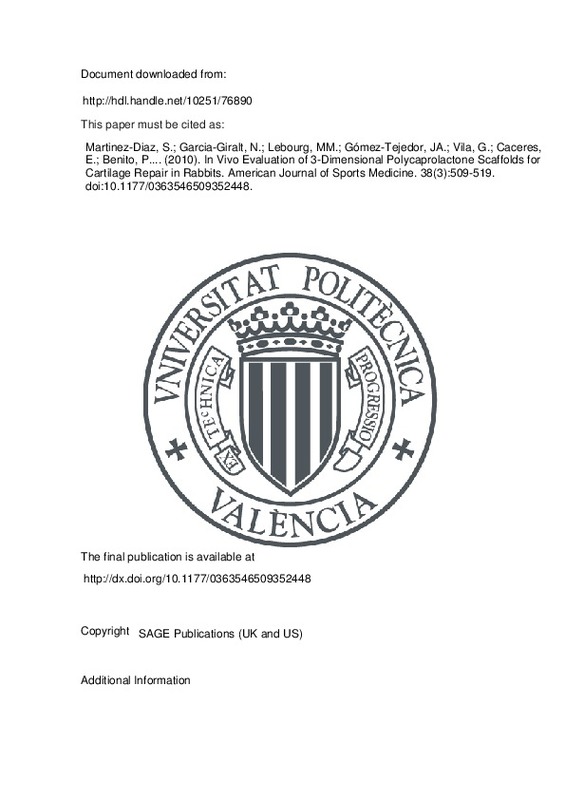Martinez-Diaz, S.; Garcia-Giralt, N.; Lebourg, MM.; Gómez-Tejedor, JA.; Vila, G.; Caceres, E.; Benito, P.... (2010). In Vivo Evaluation of 3-Dimensional Polycaprolactone Scaffolds for Cartilage Repair in Rabbits. American Journal of Sports Medicine. 38(3):509-519. https://doi.org/10.1177/0363546509352448
Por favor, use este identificador para citar o enlazar este ítem: http://hdl.handle.net/10251/76890
|
Título:
|
In Vivo Evaluation of 3-Dimensional Polycaprolactone Scaffolds for Cartilage Repair in Rabbits
|
|
Autor:
|
Martinez-Diaz, Santos
Garcia-Giralt, Natalia
Lebourg, Myriam Madeleine

 Gómez-Tejedor, José Antonio
Vila, Gemma
Caceres, Enric
Benito, Pere
Gómez-Tejedor, José Antonio
Vila, Gemma
Caceres, Enric
Benito, Pere

 Monleón Pradas, Manuel
Nogues, Xavier
Monleón Pradas, Manuel
Nogues, Xavier

 Gómez Ribelles, José Luís
Monllau, Joan Carles
Gómez Ribelles, José Luís
Monllau, Joan Carles
|
|
Entidad UPV:
|
Universitat Politècnica de València. Centro de Biomateriales e Ingeniería Tisular - Centre de Biomaterials i Enginyeria Tissular
Universitat Politècnica de València. Escuela Técnica Superior de Ingenieros Industriales - Escola Tècnica Superior d'Enginyers Industrials
Universitat Politècnica de València. Escuela Técnica Superior de Ingeniería del Diseño - Escola Tècnica Superior d'Enginyeria del Disseny
|
|
Fecha difusión:
|
|
|
Resumen:
|
Background: Cartilage tissue engineering using synthetic scaffolds allows maintaining mechanical integrity and withstanding
stress loads in the body, as well as providing a temporary substrate to which transplanted cells ...[+]
Background: Cartilage tissue engineering using synthetic scaffolds allows maintaining mechanical integrity and withstanding
stress loads in the body, as well as providing a temporary substrate to which transplanted cells can adhere.
Purpose: This study evaluates the use of polycaprolactone (PCL) scaffolds for the regeneration of articular cartilage in a rabbit model.
Study Design: Controlled laboratory study.
Methods: Five conditions were tested to attempt cartilage repair. To compare spontaneous healing (from subchondral plate
bleeding) and healing due to tissue engineering, the experiment considered the use of osteochondral defects (to allow blood
flow into the defect site) alone or filled with bare PCL scaffold and the use of PCL-chondrocytes constructs in chondral defects.
For the latter condition, 1 series of PCL scaffolds was seeded in vitro with rabbit chondrocytes for 7 days and the cell/scaffold
constructs were transplanted into rabbits’ articular defects, avoiding compromising the subchondral bone. Cell pellets and bare
scaffolds were implanted as controls in a chondral defect.
Results: After 3 months with PCL scaffolds or cells/PCL constructs, defects were filled with white cartilaginous tissue; integration
into the surrounding native cartilage was much better than control (cell pellet). The engineered constructs showed histologically
good integration to the subchondral bone and surrounding cartilage with accumulation of extracellular matrix including type II
collagen and glycosaminoglycan. The elastic modulus measured in the zone of the defect with the PCL/cells constructs was
very similar to that of native cartilage, while that of the pellet-repaired cartilage was much smaller than native cartilage.
Conclusion: The results are quite promising with respect to the use of PCL scaffolds as aids for the regeneration of articular
cartilage using tissue engineering techniques.
[-]
|
|
Palabras clave:
|
Polycaprolactone scaffold
,
Chondrocytes
,
Articular cartilage
,
Tissue engineering
|
|
Derechos de uso:
|
Reserva de todos los derechos
|
|
Fuente:
|
American Journal of Sports Medicine. (issn:
0363-5465
)
|
|
DOI:
|
10.1177/0363546509352448
|
|
Editorial:
|
SAGE Publications (UK and US)
|
|
Versión del editor:
|
http://dx.doi.org/10.1177/0363546509352448
|
|
Código del Proyecto:
|
info:eu-repo/grantAgreement/MEC//MAT2007-66759-C03-01/ES/NUEVOS SUBSTRATOS POLIMERICOS BIORREABSORBIBLES PARA LA REGENERACION DEL CARTILAGO ARTICULAR/
info:eu-repo/grantAgreement/MEC//MAT2007-66759-C03-02/ES/ESTUDIO DE LA REGENERACION DEL CARTILAGO ARTICULAR CON SOPORTES TRIDIMENSIONALES BIODEGRADABLES EN UN MODELO IN VIVO DE CONEJO/
info:eu-repo/grantAgreement/GVA//GVPRE%2F2008%2F160/
info:eu-repo/grantAgreement/Generalitat de Catalunya//2005 SGR 00762/
info:eu-repo/grantAgreement/Generalitat de Catalunya//2005 SGR 00848/
|
|
Agradecimientos:
|
The support of the Spanish Ministry of Science through projects No. MAT2007-66759-C03-01 and MAT2007-66759C03-02 (including FEDER financial support) is acknowledged. Dr Gomez Tejedor acknowledges the support given by the ...[+]
The support of the Spanish Ministry of Science through projects No. MAT2007-66759-C03-01 and MAT2007-66759C03-02 (including FEDER financial support) is acknowledged. Dr Gomez Tejedor acknowledges the support given by the government of Valencia, the Generalitat Valenciana, through the GVPRE/2008/160 project. The support of Grant 2005SGR 00762 and 2005SGR 00848 (Catalan Department of Universities, Research and the Information Society) is also acknowledged. The Aging and Fragile Elderly cooperative research network (Red Tematica de Investigacion Cooperativa en Envejecimiento y Fragilidad [RETICEF]) and the Bioengineering, Biomaterials and Nanomedicine research network (Centro de Investigacion Biomedica en Red en Bioingenieria, Biomateriales y Nanomedicina [CIBER BBN]) are initiatives of the Instituto de Salud Carlos III (ISCIII). The group of the Centro de Investigacion Principe Felipe (CIPF) acknowledges funding in the framework of the collaboration agreement among the ISCIII, the Conselleria de Sanidad de la Comunidad Valenciana, and the CIPF for the "Investigacion Basica y Traslacional en Medicina Regenerativa."
[-]
|
|
Tipo:
|
Artículo
|







![[Cerrado]](/themes/UPV/images/candado.png)


